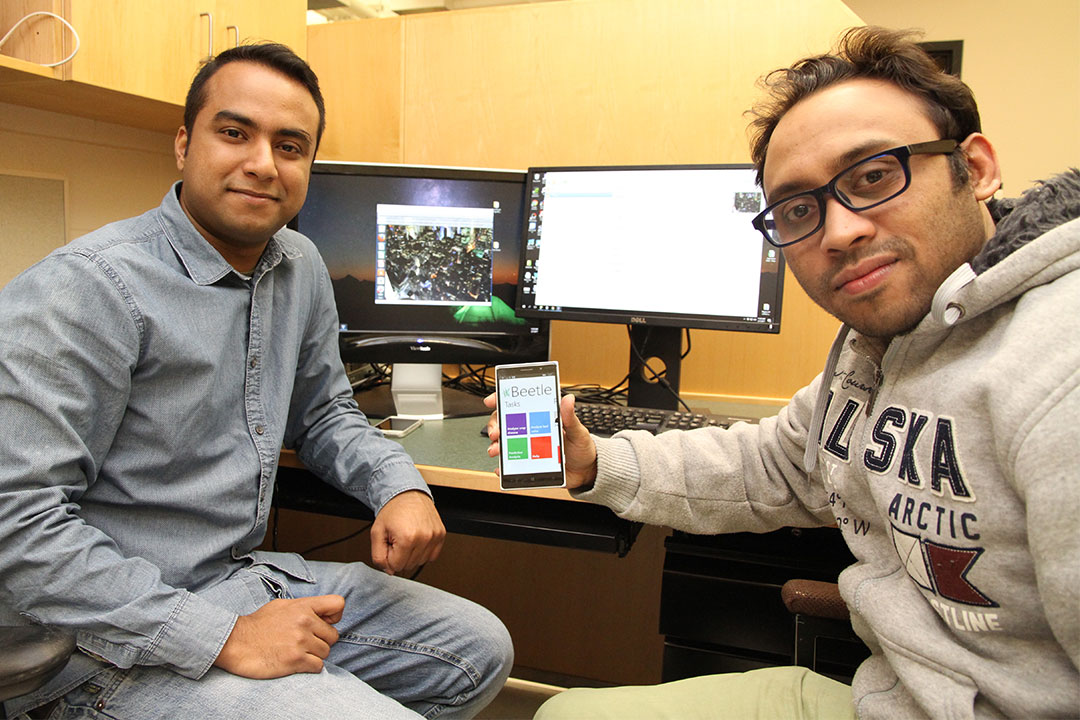
App maps crop health
A few months ago, Rahat Yasir visited a farmer from Tisdale. He listened as the man spoke of walking through the crops, painstakingly inspecting for signs of crop disease, pest infestation and areas in need of herbicide or fertilizer.
By HenryTye GlazebrookThe process may be a far cry from the work expected of a first-year master’s student in computer science at the University of Saskatchewan, but it is vital for Yasir, a young developer working on a mobile application that will help farmers survey crop health with unheard of efficiency.
“They are still doing the manual process,” Yasir said. “They are walking through the fields and checking each individual leaf to see if there are visual changes, and then they apply medicine all over the land. If they use our system, they won’t need to do that.”
Yasir is building the project, a mobile application dubbed Project Beetle, in partnership with fellow first-year computer science master’s student Rashid Chowdhury. It is designed as an easy-to-use application for mobile phones that will allow farmers direct access to diagnostic
information, identifying potential diseases through visual changes in their crops and predicting when and where larger outbreaks may occur.
One needs only to take a photo of a leaf and wait a few moments as the app scans it and provides a detailed breakdown of possible health issues, including potential diseases and nutritional information, as well as an estimate of how much of the surrounding crop is similarly affected.
In January, the app earned first place in the Emerging Agriculture Hackathon. The contest, an annual event hosted by the U of S Junior Chamber of Commerce, brings together students of technology and agriculture to compete and collabo rate on computer programming and related projects.
“We started almost four years ago,” Yasir said. “This project was originally designed for rice paddy crop diseases, then for this emerging Agriculture Hackathon we have updated the software, added predic tive analysis, and at the same time we have made it universal, so that it can predict any type of crop diseases for any type of crops.”
Project Beetle works through the use of artificial neural networks, which have made it possible for Yasir and Chowdhury to compress the entirety of their informational database on different crop diseases directly within the app itself. The result is an app that functions even without access to internet, though it does become more expansive when running online.
The next steps are to hopefully partner with others working in similar areas, or with government agencies from which the duo will be granted even greater access to data on crop diseases.
“If there is an existing system that’s already supporting problems, we could do a collaboration,” Yasir said. “Our tool is very handy and they could integrate it with their own very easily. And at the same time, our system would get access to their data. It would be a perfect collaboration. Once we get more data, our system will start to show us amazing results.”
Yasir and Chowdhury first met during their undergraduate program at North South University in Dhaka, Bangladesh, and quickly banded together on a passion project that they believe has the potential to save billions of dollars in crop losses annually.
The two students have always been driven by a desire to curb world hunger, but their interest ignited when they started looking into global statistics that estimated nearly one billion people are starving annually, while 15-20 per cent of crops are lost due to preventable issues such as crop disease, lack of herbicides and improper fertilization.
“We came up with the idea that if we could develop something or come up with some solution that can reduce the number of crops lost to crop diseases or insects, then we would be able to make our world hunger-free,” Yasir said.

